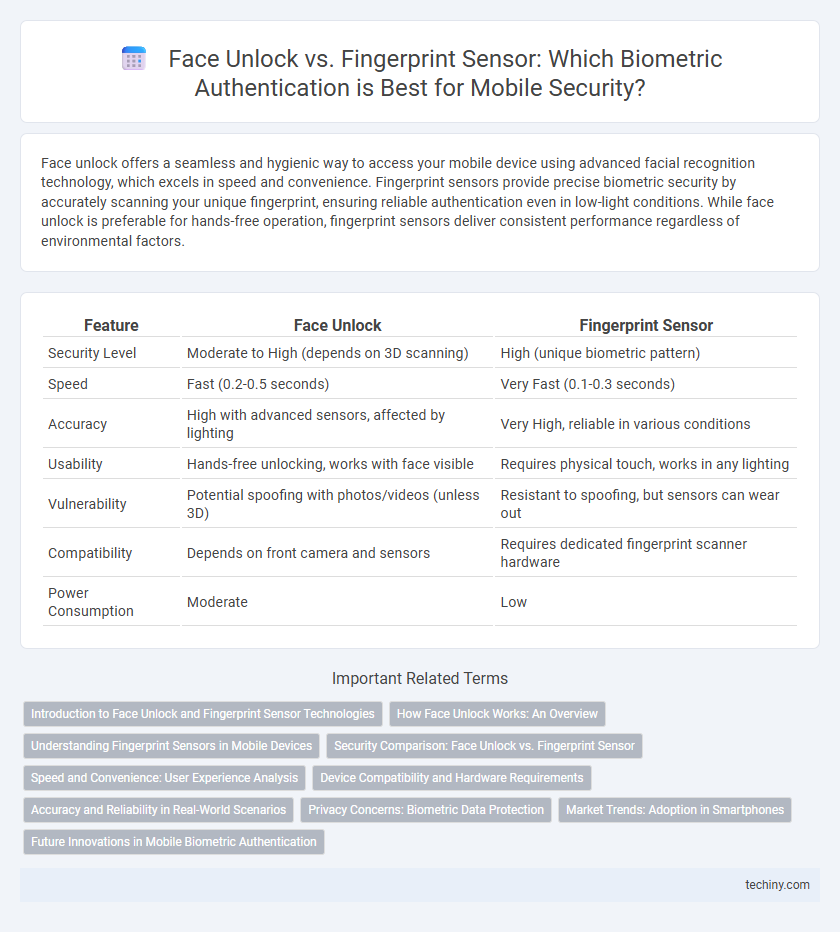Face unlock offers a seamless and hygienic way to access your mobile device using advanced facial recognition technology, which excels in speed and convenience. Fingerprint sensors provide precise biometric security by accurately scanning your unique fingerprint, ensuring reliable authentication even in low-light conditions. While face unlock is preferable for hands-free operation, fingerprint sensors deliver consistent performance regardless of environmental factors.
Table of Comparison
| Feature | Face Unlock | Fingerprint Sensor |
|---|---|---|
| Security Level | Moderate to High (depends on 3D scanning) | High (unique biometric pattern) |
| Speed | Fast (0.2-0.5 seconds) | Very Fast (0.1-0.3 seconds) |
| Accuracy | High with advanced sensors, affected by lighting | Very High, reliable in various conditions |
| Usability | Hands-free unlocking, works with face visible | Requires physical touch, works in any lighting |
| Vulnerability | Potential spoofing with photos/videos (unless 3D) | Resistant to spoofing, but sensors can wear out |
| Compatibility | Depends on front camera and sensors | Requires dedicated fingerprint scanner hardware |
| Power Consumption | Moderate | Low |
Introduction to Face Unlock and Fingerprint Sensor Technologies
Face unlock technology uses advanced facial recognition algorithms and infrared sensors to quickly map and verify unique facial features for secure access. Fingerprint sensors capture and analyze fingerprint patterns through capacitive or optical methods, providing reliable biometric authentication. Both technologies enhance mobile security by offering convenient, personalized unlocking mechanisms tailored to user preferences and device capabilities.
How Face Unlock Works: An Overview
Face unlock technology utilizes advanced facial recognition algorithms combined with infrared sensors or structured light to map and analyze unique facial features for secure device access. It captures a detailed 3D facial scan, comparing it against stored biometric data to authenticate identity accurately even in low-light conditions. This method enhances user convenience by enabling quick, hands-free unlocking while maintaining high security standards.
Understanding Fingerprint Sensors in Mobile Devices
Fingerprint sensors in mobile devices utilize capacitive, optical, or ultrasonic technology to capture and analyze the unique patterns of ridges and valleys on a user's finger for authentication. Capacitive sensors detect electrical signals from the skin, offering high accuracy and security, while optical sensors use light to capture fingerprint images, often found in budget devices. Ultrasonic sensors provide advanced 3D mapping of fingerprints, enhancing security and performance even under challenging conditions like wet or oily fingers.
Security Comparison: Face Unlock vs. Fingerprint Sensor
Face unlock technology uses advanced infrared sensors and 3D mapping to accurately authenticate users, providing strong protection against spoofing attempts compared to basic 2D facial recognition. Fingerprint sensors offer biometric security through unique patterns stored in encrypted form, exhibiting high accuracy and resistance to false acceptance. While both methods deliver robust security, fingerprint sensors generally maintain superior reliability in diverse lighting and environmental conditions.
Speed and Convenience: User Experience Analysis
Face unlock technology offers rapid access by scanning facial features in a fraction of a second, providing a seamless user experience with minimal effort. Fingerprint sensors require physical contact and typically take slightly longer due to sensor alignment and recognition time, yet they remain highly reliable in various lighting conditions. Users seeking swift and effortless device access often prefer face unlock for its speed, while fingerprint sensors are favored for consistent performance and security.
Device Compatibility and Hardware Requirements
Face unlock requires advanced front-facing cameras with infrared sensors or structured light technology, limiting its availability to newer smartphones with specialized hardware. Fingerprint sensors, available in both optical and ultrasonic forms, offer broader device compatibility, including mid-range and older models, due to their simpler integration under or beside the display. Hardware demands for fingerprint sensors are less intensive compared to face unlock systems, making fingerprint authentication more accessible across diverse mobile devices.
Accuracy and Reliability in Real-World Scenarios
Face unlock systems leverage advanced infrared and 3D mapping sensors to enhance accuracy, especially in varied lighting conditions, though they may struggle with identical twins or rapid environmental changes. Fingerprint sensors provide consistent reliability across diverse scenarios, offering quick authentication with a low false acceptance rate due to unique biometric patterns. Real-world usage shows fingerprint sensors maintaining superior accuracy in wet or dirty environments where face unlock might fail, making them a dependable choice for secure mobile access.
Privacy Concerns: Biometric Data Protection
Face unlock and fingerprint sensors both rely on unique biometric data, raising significant privacy concerns regarding unauthorized access and potential data breaches. Advanced encryption methods and secure hardware enclaves are critical for protecting stored biometric templates from malicious attacks. Users must ensure their devices adhere to stringent data protection standards such as GDPR or CCPA to mitigate risks associated with biometric authentication.
Market Trends: Adoption in Smartphones
Face unlock technology has rapidly gained traction in premium smartphones, with adoption rates soaring due to advancements in 3D facial recognition and improved front camera sensors. Fingerprint sensors, especially under-display variants, continue to dominate mid-range and budget segments, offering a reliable and cost-effective biometric solution. Market trends indicate a growing integration of both technologies within flagship devices, reflecting consumer demand for enhanced security and convenience.
Future Innovations in Mobile Biometric Authentication
Future innovations in mobile biometric authentication are expected to enhance the accuracy and speed of both face unlock and fingerprint sensor technologies through advanced AI algorithms and 3D sensing. Emerging methods like under-display fingerprint sensors and facial recognition combined with infrared and ultrasonic scanning aim to improve security and usability in diverse lighting conditions. Integration of multimodal biometrics, which merges face unlock and fingerprint data, is poised to deliver seamless and highly secure user authentication experiences in next-generation mobile devices.
Face unlock vs Fingerprint sensor Infographic

 techiny.com
techiny.com